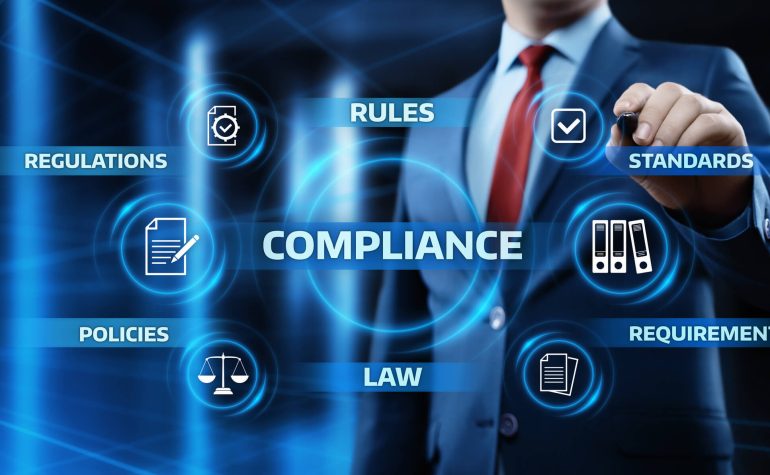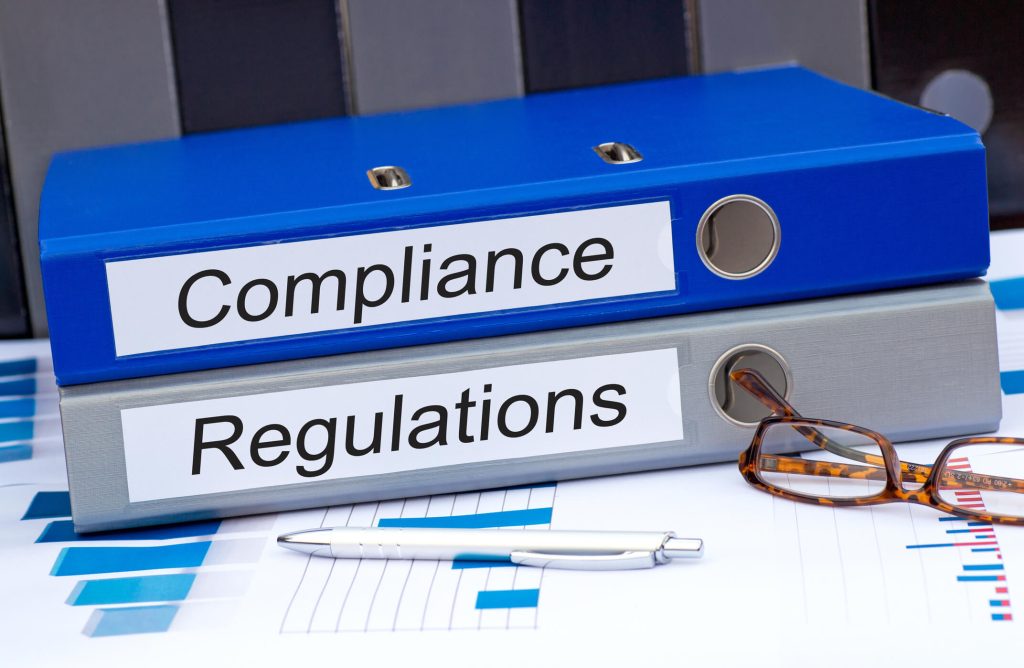
By alphacardprocess April 5, 2024
Regulatory compliance is a critical aspect of operating a high-risk business. High-risk industries, such as financial services, healthcare, gambling, and adult entertainment, are subject to stringent regulatory requirements. These regulations aim to protect consumers, prevent money laundering, ensure fair competition, and maintain the integrity of the industry. However, navigating the complex landscape of regulatory compliance can be challenging for high-risk merchants.
This article will provide an overview of regulatory requirements for high-risk industries, discuss the unique challenges faced by high-risk merchants, explore compliance challenges and solutions, emphasize the importance of staying updated on regulatory changes, and highlight the implications of non-compliance for high-risk businesses. Additionally, strategies for achieving and maintaining regulatory compliance will be discussed, along with frequently asked questions about regulatory compliance for high-risk businesses.
What is Regulatory Compliance?
Regulatory compliance refers to the process by which businesses adhere to laws, regulations, guidelines, and specifications relevant to their operations. For high-risk businesses, compliance is not just about following rules; it’s about ensuring transparency, integrity, and the protection of consumer interests.
Why is it Crucial for High-Risk Businesses?
For high-risk industries, the stakes of non-compliance are particularly high, including hefty fines, legal repercussions, damage to reputation, and the potential revocation of licenses to operate. Moreover, compliance helps in building trust with customers, partners, and regulators, which is fundamental for long-term success.
Overview of Regulatory Requirements for High-Risk Industries
High-risk industries, such as financial services, healthcare, gambling, adult entertainment, cryptocurrency, and firearms, are subject to stringent regulations due to the potential for financial crimes, consumer harm, or societal concerns associated with their operations. These industries must comply with a wide range of regulations, including but not limited to:
- Anti-Money Laundering (AML) Regulations: High-risk businesses are required to implement robust AML programs to prevent money laundering and terrorist financing. These programs include customer due diligence, transaction monitoring, and reporting suspicious activities to regulatory authorities.
- Know Your Customer (KYC) Regulations: High-risk businesses must verify the identity of their customers to prevent fraud, money laundering, and other illicit activities. KYC procedures involve collecting and verifying customer information, such as identification documents and proof of address.
- Data Privacy and Security Regulations: High-risk businesses that handle sensitive customer data, such as healthcare providers and financial institutions, must comply with data privacy and security regulations, such as the Health Insurance Portability and Accountability Act (HIPAA) and the General Data Protection Regulation (GDPR).
- Licensing and Permitting Requirements: Certain high-risk industries, such as gambling and firearms, require specific licenses and permits to operate legally. These licenses often come with additional compliance obligations, such as regular audits and reporting.
- Consumer Protection Regulations: High-risk businesses must comply with consumer protection laws to ensure fair and transparent practices. These regulations may include restrictions on advertising, disclosure requirements, and dispute resolution mechanisms.
Understanding the specific regulations applicable to each industry is crucial for high-risk merchants to operate legally and ethically.
Understanding the Unique Challenges Faced by High-Risk Merchants

High-risk merchants face unique compliance challenges due to the nature of their businesses. These challenges include:
- Complex Regulatory Frameworks: High-risk industries are often subject to multiple layers of regulations from various regulatory bodies, such as government agencies, industry associations, and self-regulatory organizations. Navigating these complex frameworks can be overwhelming for high-risk merchants.
- Evolving Compliance Standards: Regulatory requirements and industry standards are constantly evolving. High-risk merchants must stay updated on these changes to ensure ongoing compliance. Failure to do so can result in severe consequences, including legal penalties, reputational damage, and loss of customer trust.
- Robust Risk Management Systems: High-risk businesses must have robust risk management systems in place to identify, assess, and mitigate compliance risks. This includes conducting regular risk assessments, implementing internal controls, and monitoring compliance activities.
To overcome these challenges, high-risk merchants must implement comprehensive compliance programs, conduct regular risk assessments, and leverage technology solutions to streamline compliance processes.
Regulatory Compliance Challenges and Solutions for High-Risk Merchants
Compliance challenges for high-risk merchants can be addressed through various solutions:
- Comprehensive Compliance Programs: High-risk merchants should establish a robust compliance program that includes policies, procedures, and internal controls tailored to their specific industry and risk profile. This program should be well-documented, outlining compliance requirements and expectations for employees.
- Regular Risk Assessments: High-risk merchants should conduct regular risk assessments to identify and address compliance gaps. These assessments should evaluate the effectiveness of existing controls, identify emerging risks, and prioritize remediation efforts.
- Training and Education: Regular training and education for employees on compliance requirements and expectations are essential. This ensures that employees are aware of their compliance obligations and understand the potential consequences of non-compliance.
- Technology Solutions: Leveraging technology solutions can streamline compliance processes and ensure accuracy and efficiency. Compliance management software can centralize compliance-related data, automate reporting, and provide real-time monitoring of compliance activities. This reduces the burden on high-risk merchants’ operations and reduces the risk of human error.
By implementing these solutions, high-risk merchants can overcome compliance challenges and ensure ongoing compliance with regulatory requirements.
The Importance of Staying Updated on Regulatory Changes

Regulatory Compliance landscapes are constantly evolving, with new laws, regulations, and industry standards being introduced regularly. High-risk merchants must stay updated on these changes to ensure ongoing compliance. Failure to do so can result in severe consequences, including legal penalties, reputational damage, and loss of customer trust.
Staying updated on regulatory changes can be achieved through the following strategies:
- Regular Monitoring: High-risk merchants should regularly monitor regulatory updates from relevant regulatory bodies, industry associations, and legal publications. This can be done through subscribing to newsletters, following industry news, and engaging with industry associations.
- Engaging with Industry Associations: Joining industry associations and participating in industry events can provide high-risk merchants with valuable insights into regulatory changes and compliance best practices. These associations often offer resources, training programs, and networking opportunities to help high-risk merchants stay ahead of compliance requirements.
- Seeking Legal Counsel: High-risk merchants should consider seeking legal counsel to ensure they are aware of and compliant with all relevant regulations. Legal professionals specializing in the specific industry can provide guidance on compliance requirements and help navigate complex regulatory frameworks.
By staying updated on regulatory compliance changes, high-risk merchants can proactively adapt their compliance programs and mitigate the risks associated with non-compliance.
Implications of Non-Compliance for High-Risk Businesses
Non-compliance with regulatory compliance requirements can have significant implications for high-risk businesses. These implications can be categorized into legal and financial ramifications, as well as reputation and customer trust.
Consequences of Non-Compliance: Legal and Financial Ramifications
High-risk businesses that fail to comply with regulatory compliance requirements may face severe legal and financial consequences. Regulatory authorities have the power to impose substantial fines, penalties, and sanctions on non-compliant businesses. These penalties can range from monetary fines to license revocation or suspension. In some cases, non-compliance can result in criminal charges, leading to imprisonment for business owners or executives.
Financial implications of non-compliance can be equally severe. Non-compliance can disrupt business operations, resulting in revenue loss and potential bankruptcy. Legal battles to resolve non-compliance issues can be costly, with expenses including legal fees, settlements, and potential damages awarded to affected parties.
Reputation and Customer Trust: The Hidden Costs of Non-Compliance
Non-compliance not only affects a high-risk business’s legal and financial standing but also damages its reputation and erodes customer trust. Consumers expect businesses to operate ethically and responsibly, and any association with non-compliance can lead to a loss of trust. Negative publicity, customer complaints, and social media backlash can further harm a business’s reputation, making it challenging to regain customer confidence and attract new clients.
The hidden costs of non-compliance, such as reputational damage and loss of customer trust, can have long-term implications for high-risk businesses. Rebuilding a tarnished reputation can be a time-consuming and costly process, requiring significant efforts in public relations, customer outreach, and transparency.
Strategies for Achieving and Maintaining Regulatory Compliance
High-risk merchants can adopt several strategies to achieve and maintain regulatory compliance. These strategies include building a robust compliance program, leveraging technology and automation, and conducting regular risk assessments and audits.
Building a Robust Compliance Program: Best Practices for High-Risk Businesses
To build a robust compliance program, high-risk businesses should follow best practices:
- Appoint a Dedicated Compliance Officer or Team: High-risk businesses should appoint a dedicated compliance officer or team responsible for overseeing compliance efforts. This ensures accountability and provides a centralized point of contact for compliance-related matters.
- Document Policies, Procedures, and Controls: The compliance program should be well-documented, outlining policies, procedures, and controls to ensure consistency and accountability. This documentation should be easily accessible to employees and regularly updated to reflect changes in regulations or industry standards.
- Regular Training and Education: High-risk businesses should provide regular training and education for employees on compliance requirements and expectations. This ensures that employees are aware of their compliance obligations and understand the potential consequences of non-compliance.
- Conduct Periodic Internal and External Audits: Periodic internal and external audits can help identify areas for improvement and ensure ongoing compliance. These audits should evaluate the effectiveness of the compliance program, identify compliance gaps, and provide recommendations for remediation.
By following these best practices, high-risk businesses can establish a strong compliance foundation and ensure ongoing compliance with regulatory compliance requirements.
Leveraging Technology and Automation for Efficient Compliance Management
Technology and automation can significantly enhance compliance management for high-risk businesses. Compliance management software can centralize compliance-related data, automate reporting, and provide real-time monitoring of compliance activities. This streamlines processes, reduces human error, and ensures accuracy and timeliness in compliance reporting.
Additionally, leveraging artificial intelligence and machine learning can help identify patterns and anomalies, enabling proactive risk management and fraud detection. These technologies can analyze large volumes of data, identify potential compliance issues, and provide insights for decision-making.
By leveraging technology and automation, high-risk businesses can streamline compliance processes, reduce the burden on their operations, and ensure accuracy and efficiency in compliance management.
Frequently Asked Questions
Q 1: What industries are considered high-risk and subject to stringent regulations?
High-risk industries include financial services, healthcare, gambling, adult entertainment, cryptocurrency, and firearms. These industries are subject to stringent regulations due to the potential for financial crimes, consumer harm, or societal concerns associated with their operations.
Q 2: How can high-risk merchants ensure compliance without compromising their operations?
High-risk merchants can ensure compliance by implementing a comprehensive compliance program, conducting regular risk assessments, and staying updated on regulatory changes. They should also leverage technology solutions to streamline compliance processes and automate reporting, reducing the burden on their operations.
Q 3: What are the consequences of non-compliance for high-risk businesses?
Non-compliance can result in severe consequences for high-risk businesses, including legal penalties, fines, sanctions, license revocation, and reputational damage. It can also lead to loss of customer trust, revenue loss, and difficulty in attracting new customers, ultimately impacting the long-term viability of the business.
Conclusion
Regulatory compliance is a critical aspect of operating a high-risk business. Understanding the unique challenges faced by high-risk merchants and implementing effective compliance strategies are essential for long-term success. Staying updated on regulatory changes and implications is crucial to ensure ongoing compliance and mitigate the risks associated with non-compliance. By prioritizing compliance and leveraging technology solutions, high-risk businesses can navigate the complex regulatory compliance landscape and maintain their legal and ethical standing in their respective industries.
